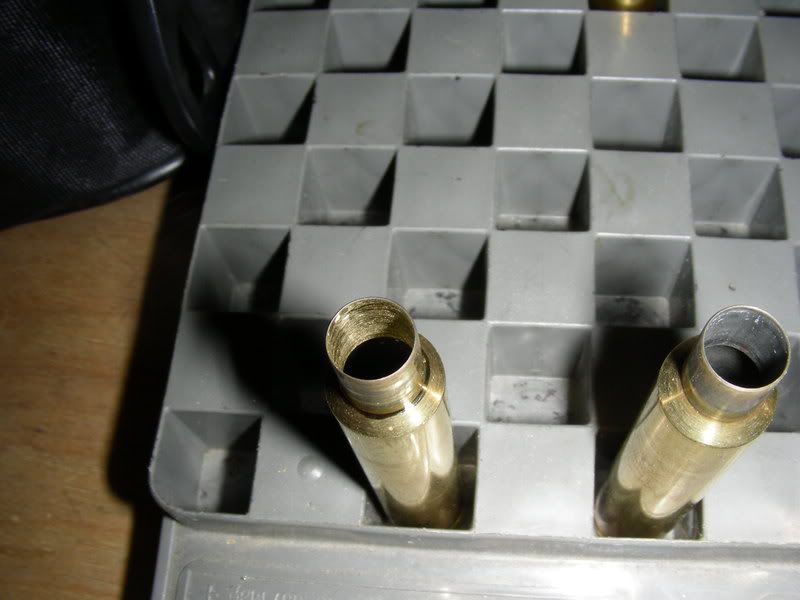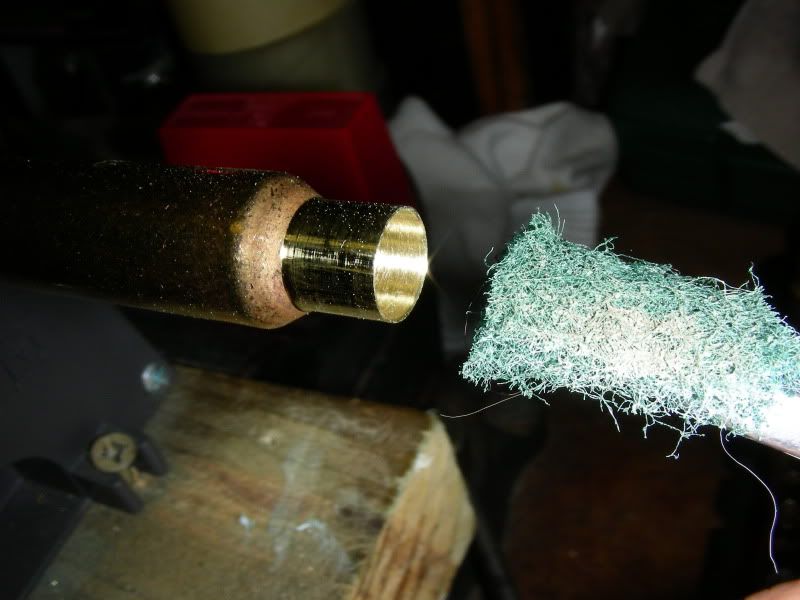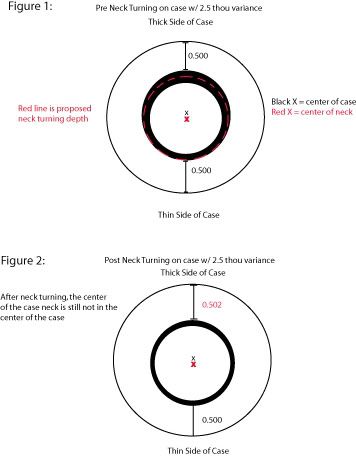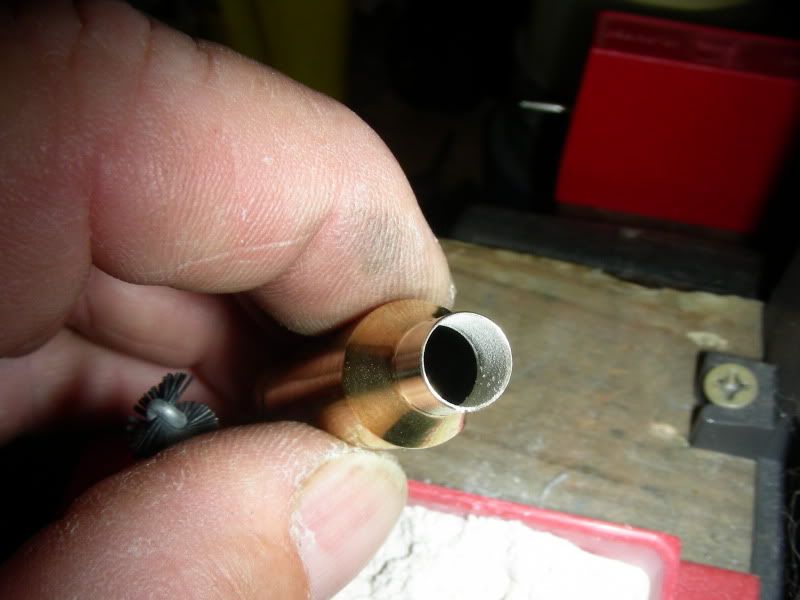

 The Accurate Reloading Forums
The Accurate Reloading Forums  THE ACCURATE RELOADING.COM FORUMS
THE ACCURATE RELOADING.COM FORUMS  Guns, Politics, Gunsmithing & Reloading
Guns, Politics, Gunsmithing & Reloading  Reloading
Reloading  Neck Turning & Neck Pressure on Bullet
Neck Turning & Neck Pressure on BulletGo  | New  | Find  | Notify  | Tools  | Reply  |  |
| new member |
I am kind of new to this precision reloading for competitive long range shooting and was hoping some of the more experienced reloaders could answer a couple of questions on neck turning and bullet to neck fit. 1 Is there a minimum wall thickness that must be maintained for safety? I realize there should not be any undercut from the turning at the shoulder area, it must be a smooth blend. 2 Is there a specific neck to bullet pressure or fit that gives the best accuracy? Example: 0.0005” per side/ 0.001” per side, or is this something that needs to be experimented with to find out just what works the best for my rifle and loads. I am loading the 7mm WSM AI. The factory case was 2.095” long with neck wall that varied from 0.0175” to 0.0150”. I cleaned one up last night to see what I might come up with and the results were as follows, I dialed the case in just past the shoulder on the main body to within .0005” bored the ID to just clean up and turned the OD to just clean up and faced the case again to just clean up. What I ended up with case length 2.090” with the face of the neck at 89.914° of perpendicularity to body center line, wall at 0.0115” to 0.0117” only 0.0002” variation in thickness. Any knowledgeable input would be appreciated. Thanks Bill | ||
|
| one of us |
You lost me at "perpendicularity" Minimum wall thickness .010" so i have read. Measure a loaded rounds neck diameter with bullet seated on a turned neck. Bushing should be .002" smaller to start. You are using bushing dies, or custom dies i hope? Measure over the pressure ring if you bullet has one. After that try more or less. Most people turn necks to fit a tight neck chamber. I am no expert, so get a 2nd opinion. Check out the forums here > http://benchrest.com/index.shtml | |||
|
One of Us |
Later tonight I may post some pics which will show some neck turning and reaming and may bring up some questions. ____________________________________ There are those who would misteach us that to stick in a rut is consistency - and a virtue, and that to climb out of the rut is inconsistency - and a vice. - Mark Twain | Chinese Proverb: When someone shares something of value with you and you benefit from it, you have a moral obligation to share it with others. ___________________________________ | |||
|
| new member |
Thanks for the input !! 243winxb Perpendicularity measurement would be the angle measured from the centerline of the case to the plane of the neck end, I can only assume that it would be best if when a bullet leaves the case that it leaves the whole contact surface evenly. At this point after fireforming I am only doing neck sizing and length trimming. I do have the ability to make my sizing bushings to any size I want and polish to a mirror finish. Woods & 243winxb It sounds like my process will be OK at 0.0115” wall thickness but I will check it every time I neck size to verify. I think I will set my neck dia. between .002” & .003” sounds like a good middle point to start. Thanks again for the input Bill | |||
|
| One of Us |
I am not sure why you both bore and turn your brass. Just turn your case necks using a mandrel. The diameter of your chamber neck is somewhat determines if or how much you turn your necks. | |||
|
One of Us |
Like SR said, no reason to outside neck turn and inside neck ream. Really the only good reason to ream is to get rid of a do-nut that you get from forming down brass or from firing a sharp shouldered case in a tight necked chamber. And you want to outside turn only enough to get rid of the neck thickness variances. After that the thicker the neck brass the better. IOW if you can get consistant neck thickness of .014" it is better than a consistant neck thickness of .011". I have to outside turn for 3 of my rifles that have tight necks. On those I have to take off enough brass that it means I have a complete turn  On turning for other rifle I will only hit the high spots to bring thicknesses into tolerance level (~.001") Notice the rough texture on the inside of the neck created by the turning mandrel  IMO important to remove or at least minimize those burrs and scratches  You should outside turn on new cases and then the subsequent firing will move the uniformed neck into alignment with the case body. However don't expect the turned cases to be in alignment or have better concentricity until they are fired again  On bullet grip like I said I like to use dry lube  and get .002" to .003" which is enough even for a 375 caliber as long as you are not nose to magazine  YMMV ____________________________________ There are those who would misteach us that to stick in a rut is consistency - and a virtue, and that to climb out of the rut is inconsistency - and a vice. - Mark Twain | Chinese Proverb: When someone shares something of value with you and you benefit from it, you have a moral obligation to share it with others. ___________________________________ | |||
|
| one of us |
here is an article from sinclair http://blog.sinclairintl.com/2...-for-factory-rifles/ I'd fire acouple rd first or find out from the gunsmith neck dia of the reamer. Once you get that you can do the math VFW | |||
|
| new member |
Thanks All again !! Good info. Can someone tell me the best set of Bushing type Die's for this type of set up? Bill | |||
|
| One of Us |
You can only get the accuracy level that the RIFLE system is capable of...so first start with a "blueprinted" rifle/receiver and good barrel...if the receiver/barrel boreline isn't square and perpendicular all the work you do on the brass is wasted. If the chamber isn't cut precisely parallel and square with the barrel bore line, the bolt face isn't square and all the rest in a "blueprinted" barrel/action, you are wasting your time and going in circles. If your rifle is blueprinted and fitted to the stock correctly then you are well on your way and can get as "persnickity" as you like and your efforts will have meaning. This should go without saying. If you're looking for a record busting rifle you have certain concerns, if it's a hunter you want the ultimate accuracy out of, there are other concerns, but basically you have to do the same things to each. I neck turn my cases just to clean up and uniform the walls to give a uniform grip/release...this will give me 1/2" to bugholes if I do my part and the rest of the system is also tuned...good for sage rats to T-Rex to 1000 yds. If you use any one of the mandrel type, hand held neck turners, use lube on the mandrel and inside of the neck and GO SLOW, the level of uniformity will be fairly even the whole length of the neck...dry or wet, they all work. If you get the mandrel of the neck turner hot it will expand by a varying amount...and will also cause brass gauling/buildup on the mandrel which will change all that precision and REALLY mess up the inside of the case neck...It doesn't take much speed or time to have a wreck...I only use low speed screwdriver motors to spin the cases now and keep things cool with ice cubes...the water helps lub the mandrel/case also. SOMETIMES I am lucky with a rented reamer, a factory chamber or a pre-fit barrel...sometimes not...as far at how close the brass fits the chamber neck. You might has some playroom with the thick neck of the WSM case. Woods examples are excellent ways to visualize what is going on...ALSO...look at the diagram as if it were the case sitting in the chamber...because there is a slight difference in case OD's AND chamber ID's the case will place the bullet slightly lower than the centerline, UNLESS you actually stuff the bullet up into the lands. This only centers the front of the case and bullet...the rear of the case is still off center by a slight amount. This is the reason to ALSO fit your sizing die to the chamber...at the front AND rear...plus keeping the brass from being "squeeze" cycled so much and giving long case life. Keeping the case base OD and chamber ID as close as possible reduces the amount of "offset" at the back end. Squaring the boltface to the boreline and fitting the bolt to the receiver bore to a minimum tolerance is also conducive to high accuracy. You also have to keep in mind there is only a certain level of "anality" useful in each rifle...going nutz over a ten thousandth of an inch in the case is as useless as boobs on a borehog if you have a chamber neck 0.010" larger than you loaded case neck OD. All this talk is great online, but doesn't mean squat in real life situations if EVERYTHING else is sloppy. I've used Redding Bushing FL dies and standard bushings since they first came out...I used Wilson before that. One trick if found or maybe read somewhere was you could sometimes get a VERY slightly larger or smaller neck sqeeze by turning the bushing upside down...it does work but only a benchrest rifle can put the difference to work. It's also very hard to measure directly...0.0001" or less is vary hard to measure accurately and precisely with any type of hand held mic. I also found out that the only way to maintain the least amount of runout on a case with anything OTHER than a benchrest quality rifle, was to use a good reloading press and make sure there was NO breakover at the top of the sizing stroke. Run your sizing die down to the top of the shell holder at the top of the stroke and THEN turn it down at least another turn and a half. Seating with a Wilson seater or one of the Forester Ultra or Redding/RCBS competition seater will keep the bullet runout low, but you need to square the bottom of your cases and FL size too keep the case in line...most of the time on a factory setup. I ran some tests on a 223 Ruger all weather SS rifle, a 308 in two different rifles, and to a lessor degree of work, a 30-06, 7mmRM, 300 RM, 8x57 Mauser, 17 Rem and 20 Practical...way back using a RCBS FL die set, a Redding FL bushing die, a Redding neck Bushing die(used the same bushing for both), and a Wilson sizer(for the 223 and 308)...I also partial sized by backing off the two FL dies. The end result was using either of the FL sizers with all the slop taken out would maintain a case runout of 0.000" to 0.002" and by spinning the case ~90° on the ones with any amount of runout would re-align them back to almost zero runout. Partial sizing, neck sizing only and the Wilson sizer seemed to impart runout up into the 0.005" - 0.008" range and now matter WHAT I did I couldn't remove it until I resized in a FL die with the press setup with no slop...as soon as I backed off the die for partial resizing the runout came back and stayed. What I'm saying is you have to treat the rifle as a system with all the factors being important and needing to be addressed. Don't go anal on one thing at the expense of all the rest...what happens is you begin to start chasing your tail when you aren't getting the results you want...you get locked on and your vision narrows to tunnel vision. Neck turning is important as is seating, the correct powder, the right bullet, ALL the required measurments and sorting, but trying to achieve a level of precision and accuracy the rest of the system isn't capable of or can't use, takes away all the fun and doesn't produce anything but belly aches and the redazz. Luck | |||
|
| one of us |
You mention that "I am loading the 7mm WSM AI" do you have custom dies? VFW | |||
|
| One of Us |
If you get a donut inside you case necks from forming brass from another caliber case when you pull the expander plug back through it, it then pushes the donut to the outside and a neck turning will trim it out. Even if there is spring back from the expander plug after you fire them and resize them chuck them in your neck turner you'd get rid of what remains. Even after neck turning you'll find that firing your brass that the necks can again thicken and unevenly in many cases. It's essential to have a tight fitting pilot when neck turning to insure the turning accuracy, but not so tight that is galls the inside of the neck from being too tight. | |||
|
| One of Us |
One of the all time best posts on this forum. I shoot some oddball rifles that you cannot readily buy brass for. I have made brass to fit from other cases that had a tight fit at the base. Some times the fit is in the .001 clearance range. You would be amazed at the accuracy some of the old rifle produce due to having a case that cannot swell up on one side. By Foobar,
| |||
|
| One of Us |
If you shoot a cartridge that can be made from another longer and thicker brass case you can fill up some, if not most, of that sloppy chamber neck area. An example is using a military 30-06 case to form a case that is much short where the thicker part of the 06 case with become the neck of the case you are forming to. You will definitely have to neck turn or ream, your preference, because the new neck will be tapered and also have the donut. This oftens results in much more neck thickness that can fill the slop up. Even going more drastic is making a swage that can also size down the larger and much harder to size head area. Example: sizing 06 into 6.5x54MS. Another example: Making 6.5 Jap from 308 cases. The idea is to center the bullet much as possible with the center of the bore. This isn't as critical as much with jacketed bullets, especially normal sporter/hunting rifles, but is very critical in getting the best accuracy when shooting cast bullets. Turning the necks also should help the case neck give even bullet tension all the way around. | |||
|
| One of Us |
Been there and done that also SR4759. It is very satisfying to get an oddball working and have it shoot well. SmokinJ: Back in the day, I had a Douglas premium air gauged barreled 6mm Rem chamber cut with a fired case neck OD measuring 0.284"...WAY over SAAMI specs...but was minimum SAAMI in all the other dimensions. I think the 'smith messed up and used a 25 cal throater to cut the neck. I was just beginning in this game, was jumping around like a jackrabbit from place to place so never realized what had happened until it was way too late to squal. I ended up using 270 W, 280 Rem and LC match cases to get the neck walls thick enough to turn to leave 0.002" clearance...just BARELY. I also had the sizer die worked over by RCBS to get things matched up...then polish down an expander button to get that end working. It turned out to be an excellent shooter with 70 gr Speer bullets, but it sure was a PITA getting things sorted out. Learned a lesson or seven a NY minute. Luck | |||
|
| new member |
FOOBAR Thanks for you in depth information, As far as my rifle go’s I have addressed everything that is possible to make an accurate rifle and added some features of my own design to hopefully deal with harmonics, muzzle rise (before the bullet leaves the barrel) and recoil , I did a lot of research and spent some time with Gordy Gritters to get some hands on basics. I am very knowledgeable in all aspects of custom machining and never need to ask how to do something just what needs to be done. I started with a Savage Target action and a Krieger barrel, 4 groove 1 in 8.5 everything else I built myself. It took me a year &a half but I am very pleased on how things came out and how it is shooting so far. I have only put about 65 fire forming rounds through it but things are looking good. It’s all about alignment and clearances as you know. I would be happy to share pictures and design elements if anyone is interested. I recently spoke with Walt Berger on my design and he was quite interested in my approach but he said he has always had something in his 3 aluminum stocked rifles ( fliers or inconsistent groups) that he could never figure out. I don’t seem to have these issues so maybe I hit onto a design that works. I think what I have taken away from these neck turning discussions is at this point I have well over 1,000 new 7mm WSM brass that I am just going to sort through and pick a couple hundred of the best ones and just do minimal turning cleanup because when I ordered my chamber ream from Pacific Tool I only specified AI so I can only believe they made the ream to book specks on the neck diameter and I don’t want to try to increase accuracy by working over the case necks only to have too much clearance between my turned neck and the chamber neck Dia. That might be counterproductive. Maybe the next ream I order and I want to really control my case neck fitment I will order the chamber ream accordingly. Thanks again to everyone, I have a lot to learn in this area but am looking forward to the journey. Bill | |||
|
| One of Us |
Yeah, IMHO, it's Lee's collet neck sizer. Otherwise I don't think the name on a bushing die matters a bit. I LOVE to make my .308, .243, .22-250 and 6mm Internation from .35 Whelen, .30-06, .270 cases. | |||
|
| One of Us |
A good way to cull out your cases, besides weighing them etc., is when you shoot pay attention to which shot is most out of the groups you shoot and make note of which case that bullet was loaded it. Then set that case aside and don't use it. | |||
|
| One of Us |
Ah yes, "fire culling". You can measure and weight and angst until the cows come home in the shop but sooner or later, you have to put your little gem in a rifle and send it down range. Only then does all that theory you've been working with become reality! Aim for the exit hole | |||
|
| One of Us |
| |||
|
| one of us |
That is about the 5th time I read that and it still amazes me every time. Thank you for sharing the link. I really need to stop obsessing over powder charge weight... it obviously doesn't make a difference but I just can't seem to help my neurotic self for worrying about it. | |||
|
| Powered by Social Strata |
| Please Wait. Your request is being processed... |
|
 The Accurate Reloading Forums
The Accurate Reloading Forums  THE ACCURATE RELOADING.COM FORUMS
THE ACCURATE RELOADING.COM FORUMS  Guns, Politics, Gunsmithing & Reloading
Guns, Politics, Gunsmithing & Reloading  Reloading
Reloading  Neck Turning & Neck Pressure on Bullet
Neck Turning & Neck Pressure on Bullet

Visit our on-line store for AR Memorabilia

